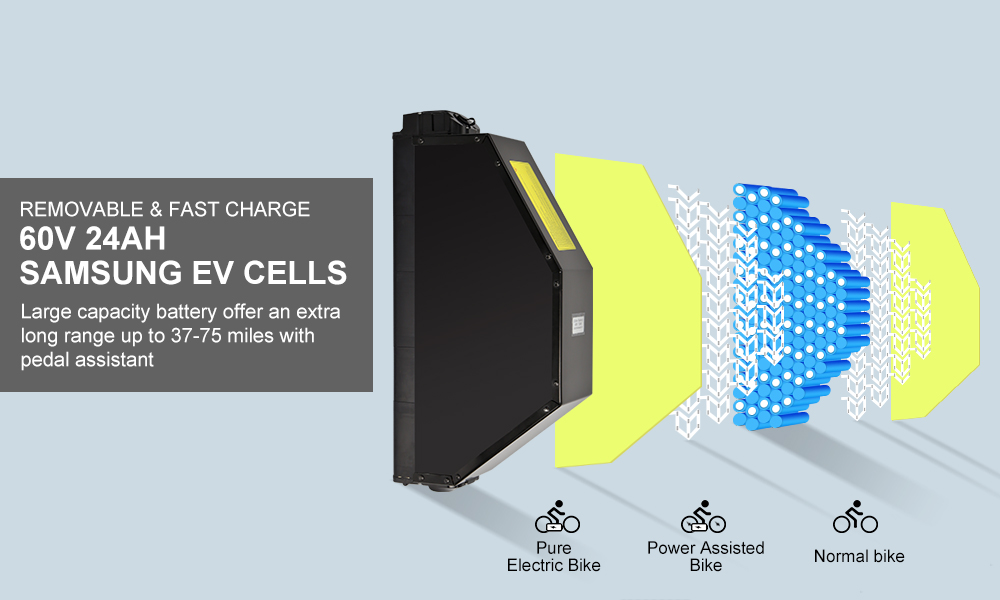Electric bikes, also known as e-bikes, have become a popular mode of transportation for urban commuters and outdoor enthusiasts alike. While the motor provides the power to propel the bike forward, the battery is what makes it possible to ride long distances without tiring out. In this blog post, we will discuss the basics of electric bike batteries.
Some suggestions that are good for battery life.
1. Pay attention to the charging method. When the new battery is charged for the first time, please take 6-8 hours to ensure that it is fully charged.
2. Pay attention to heat dissipation during charging. Avoid charging in direct sunlight, please charge indoors in winter. The battery is not allowed to approach high temperature heat source. Battery charging environment temperature is between -5℃ and +45℃.
3. Do not leave the battery in damp places or in water. Do not apply external force to the battery or make it fall overhead.
4. Do not disassemble the battery or modify it without authorization.
5. Need to use a dedicated charger for charging. There should be no short circuit at the battery interface.
6.Do not use electric bicycle on steep mountain slopes for a long time, avoid instantaneous large current discharge.
7. Do not drive with overload. When the meter shows that the battery is insufficient during driving, use the pedals to assist the riding, because deep discharge will greatly deplete the battery life.
8. When the battery is not in use, it should be stored in a cool and dry place, and be insulated to prevent the heavy pressure and children from touching, and should be fully charged every two months.

There are three main types of electric bike batteries: lead-acid, nickel-metal hydride (NiMH), and lithium-ion (Li-ion). Lead-acid batteries are the oldest and cheapest type of battery, but they are also the heaviest and least efficient. NiMH batteries are lighter and more efficient than lead-acid batteries, but they are also more expensive. Li-ion batteries are the most advanced and efficient type of battery, with the highest energy density and longest lifespan.
Voltage and amp-hours are the two main factors that determine the capacity of an electric bike battery. Voltage is the electrical pressure that drives the current through the motor, while amp-hours measure the amount of electrical energy stored in the battery. Higher voltage means more power, while higher amp-hours mean longer range.
Proper care and maintenance can help extend the lifespan of your electric bike battery. Here are some tips to keep in mind:
Lithium-ion batteries should be kept at a temperature of 20 to 25°C (68 to 77°F) for optimal performance and longevity. Extreme temperature conditions, whether hot or cold, can damage the cells, reducing the overall lifespan of the battery.
When the electric bike is not in use, it is important to remove the battery and store it in a cool, dry place. Ideally, the temperature in the storage area should be between 20 and 25°C (68 and 77°F). Storing the battery in a damp or excessively hot environment can cause damage to the cells and reduce the lifespan of the battery.
Lithium-ion batteries should not be fully depleted. In fact, it is best to avoid deep discharge cycles altogether to reduce the risk of damage to the cells. Ideally, the battery should be recharged before it gets below 20%. It is also recommended to avoid leaving the battery for prolonged periods of time without charge, as this can reduce the overall capacity of the battery.
When winter comes around, it’s important to take extra care when using and storing your electric bike battery. Cold temperatures can cause the battery to lose some of its capacity and may even damage the cells if left unused for too long. Here are a few tips to help you care for your electric bike battery during the winter months:
1. Charge Your Battery Indoors: If possible, charge your battery indoors where the temperature is more moderate. Cold temperatures can slow down the charging process and may not allow the battery to reach full capacity.
2. Keep Your Battery Warm: If you’re going to be riding your electric bike in colder temperatures, keep your battery warm by wrapping it in a blanket or insulating it with a battery cover. This will help to maintain its performance and longevity.
3. Store Your Battery in a Warm Location: If you’re not planning to use your electric bike during the winter months, store the battery in a warm location such as a closet or garage. Make sure the battery is at least 50% charged and check on it periodically to ensure it maintains its charge.
4. Avoid Leaving Your Battery in the Cold: Leaving your battery in the cold for extended periods, such as in a car trunk or outside, can cause it to lose capacity and may even damage the cells. If you do need to leave your e-bike outside for a short period, remove the battery and take it inside with you.
By taking these precautions, you can help to extend the lifespan of your electric bike battery and ensure that it continues to perform well, even in colder temperatures. Always consult the manufacturer’s guidelines and recommendations for specific care instructions for your battery model.
 hotebike
hotebike